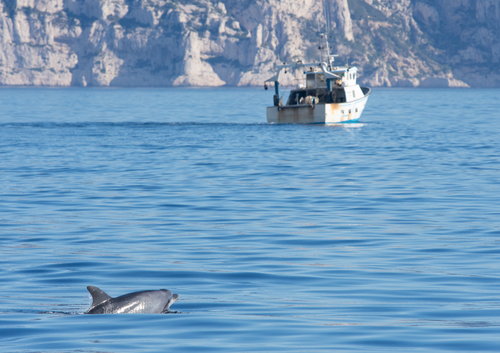


Two fields of research have grown considerably over the past twenty years: the investigation of human-wildlife conflicts (e.g. see Treves & Santiago-Ávila 2020), and multispecies occupancy modelling (Devarajan et al. 2020). In their recent study, Lauret et al. (2023) combined both in an elegant methodological framework, applied to the study of the co-occurrence of fishing activities and bottlenose dolphins in the French Mediterranean.
A common issue with human-wildlife conflicts (and, in particular, fishery by-catch) is that data is often only available from those conflicts or interactions, limiting the validity of the predictions (Kuiper et al. 2022). Lauret et al. use independent data sources informing the occurrence of fishing vessels and dolphins, combined in a Bayesian multispecies occupancy model where vessels are "the other species". I particularly enjoyed that approach, as integration of human activities in ecological models can be extremely complex, but can also translate in phenomena that can be captured as one would of individuals of a species, as long as the assumptions are made clearly. Here, the model is made more interesting by accounting for environmental factors (seabed depth) borrowing an approach from Generalized Additive Models in the Bayesian framework. While not pretending to provide (yet) practical recommendations to help conserve bottlenose dolphins (and other wildlife conflicts), this study and the associated code are a promising step in that direction.
REFERENCES
Devarajan, K., Morelli, T.L. & Tenan, S. (2020), Multi-species occupancy models: review, roadmap, and recommendations. Ecography, 43: 1612-1624. https://doi.org/10.1111/ecog.04957
Kuiper, T., Loveridge, A.J. and Macdonald, D.W. (2022), Robust mapping of human–wildlife conflict: controlling for livestock distribution in carnivore depredation models. Anim. Conserv., 25: 195-207. https://doi.org/10.1111/acv.12730
Lauret V, Labach H, David L, Authier M, & Gimenez O (2023) Using integrated multispecies occupancy models to map co-occurrence between bottlenose dolphins and fisheries in the Gulf of Lion, French Mediterranean Sea. Ecoevoarxiv, ver. 2 peer-reviewed and recommended by PCI Ecology. https://doi.org/10.32942/osf.io/npd6u
Treves, A. & Santiago-Ávila, F.J. (2020). Myths and assumptions about human-wildlife conflict and coexistence. Conserv. Biol. 34, 811–818. https://doi.org/10.1111/cobi.13472
DOI or URL of the preprint: https://doi.org/10.32942/osf.io/npd6u
Version of the preprint: 1
Dear recommender Paul Caplat,
We want to warmly thank you for your work on our manuscript and to apologize for the delay submitting our revised version. We are glad the reviewers were enthusiasts about our work. We also thank them as their work improved the clarity and the content of our manuscript. We addressed all comments in the revised manuscript and we answered each of their comments in the PDF file attached. The most important change of the revised version consists in including the appendices in the main text. Besides, we extended the Methods section to better clarify the modelling approach as suggested by the reviewers. Finally, we changed some minor points according to the suggestions of the reviewers.
We remain available for any further information,
Sincerely,
Valentin Lauret on behalf of the coauthors.
I am glad to report to the authors, albeit later than I hoped, that myself and two reviewers were really impressed with the paper, in terms of importance and clarity of methods. With that in mind, the two reviewers made interesting comments, which I would like to see addressed, as they would improve the manuscript's quality and potential impact.
 , 16 Dec 2022
, 16 Dec 2022